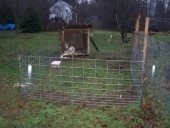posted 9 years ago
We use cattle panel hooped shelters and cover them with tarps. At first we bought standard woven medium-duty all-purpose tarps, and after two years they're toast. If you're lucky they won't have shredded to bits, but they're still just trash at that point. Anyway, they didn't overheat the shelters, though the profile (approx. 6 ft at the peak) helped. In your case, a peaked roof would work toward the same end, and would prevent water pooling.
I was going to buy treated canvas tarps this year, thinking that although they're expensive we would get more years out of them, and we could presumably patch them when needed to further extend their life. Downside (other than expense) is that they're stinking heavy.
Then I found a great deal at Bass Pro on some Redhead brand (that's a Bass Pro store label) polyester tarps made of tent fabric. They're lightweight and seem quite sturdy, though we've only been using them about four weeks. As a bonus, the stated size was actual, so a 12x16 tarp is actually 12x16'. (Most tarps are measured before the ends are folded over and sewn, and thus are smaller than the stated size.) I don't know if they're still available--I bought them on clearance a couple months ago--but surely there are other manufacturers.
That said, one upside to metal roofing is that the sheets are much more reusable than a tarp should you stop raising poultry and disassemble the shelters (this is why we opted for cattle panel shelters).









